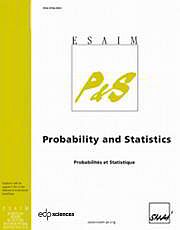Article contents
Recursive bias estimation for multivariate regressionsmoothers
Published online by Cambridge University Press: 10 October 2014
Abstract
This paper presents a practical and simple fully nonparametric multivariate smoothingprocedure that adapts to the underlying smoothness of the true regression function. Ourestimator is easily computed by successive application of existing base smoothers (withoutthe need of selecting an optimal smoothing parameter), such as thin-plate spline or kernelsmoothers. The resulting smoother has better out of sample predictive capabilities thanthe underlying base smoother, or competing structurally constrained models (MARS, GAM) forsmall dimension (3 ≤ d ≤7) and moderate sample size n ≤ 1000. Moreover our estimator is still usefulwhen d > 10and to our knowledge, no other adaptive fully nonparametric regression estimator isavailable without constrained assumption such as additivity for example. On a realexample, the Boston Housing Data, our method reduces the out of sample prediction error by20%. An R package ibr, available at CRAN, implements the proposedmultivariate nonparametric method in R.
Information
- Type
- Research Article
- Information
- Copyright
- © EDP Sciences, SMAI 2014
References
- 6
- Cited by

